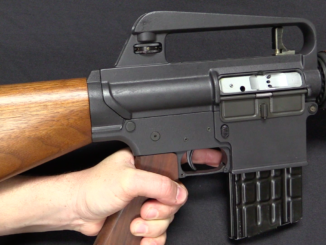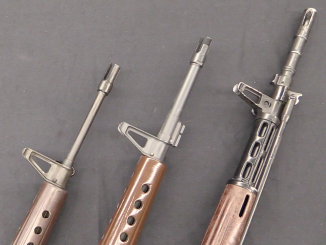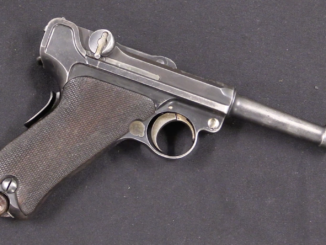During the transition from Dutch colonial rule to independence, the Dutch government armed a group of Papuans to help defend the territory form Indonesian military incursion. This organization was the Papuan Vrijwiliger Korps (Papua Volunteer Corps), and the Dutch provided them with Mauser carbines converted to 7.62mm NATO.
These carbines were originally Dutch police carbines chambers for 8mm Mauser, which the police forces were replacing with M1 Carbines. This left a group of several thousand compact and simple carbines that made an idea basis for the Papuan arms. A total of 2700 were rechambered for 7.62mm (it was not known at that point which new semiauto rifle would be adopted by the Dutch military, but it would definitely use the 7.62mm NATO cartridge). Magazine blocks were installed to fit the shorter cartridge length, and the guns were fitted with rubber buttplates, given new bayonets, and parkerized to make them more durable in the Papuan environment.
It is not known how many of the carbines actually made it to New Guinea, but a substantial number certainly did. They are extremely rare carbines today, as the Papua Volunteer Corps was an ill-fated group and only lasted from 1961 until 1963, with most of their arms being ultimately seized by the Indonesian military. This example was shared with me by a generous Dutch collector.




IIRC the Dutch regular troops (Korps Mariniers and army infantry) in what was Nederlands-Nieuw-Guinea were equipped with M1 Garands (in .30) and Bren guns (in .303) in addition to Uzi SMGs. So the Papuan volunteers seemed to be the only unit in NNG that had rifles in 7.62 NATO.
Ironically the other side of the conflict, the Indonesians had plenty of 7.62 NATO-chambered guns.
This gun was probably ‘pain in butt’ to shoot. But it is really nicely furnished and extremely well made (of course, FNH production) rifle.
Very nice piece of history was told, with wider connections, as usual. Thanks.
Assuming it is similar to the G33/40, which it resembles quite a bit, shooting it is no problem for the actual shooter. It’s the folks standing to the left or right who will have a truly unpleasant experience.
Wafa Wafa, Wasara Wasara.
You are right; there are shorter barrel rifles in these calibres.
Very interesting presentation but I don’t think you mean ‘Papua New Guinea’. You’re talking about what has variously been called West Papua, West New Guinea, Irian Jaya, and recently just ‘Papua’. It has been part of the Republic of Indonesia since 1963.
C.J. Chivers reported in his book _The Gun_ about the Kalashnikov that it was Irian Jaya where “western” Nato troops–the Dutch–first captured a Kalashnikov, a specimen taken from Indonesian special forces in about 1962 or 1963 if I recall correctly…
There was small ‘inaccuracy’, from today’s point of view. There are two Guineas now, but in time of Dutch domination just one.
https://www.google.ca/maps/place/Papua+New+Guinea/@-6.2975756,141.3548333,5z/data=!3m1!4b1!4m5!3m4!1s0x6859e8afbf0e9eaf:0xdaf0e50d8e9c127a!8m2!3d-6.314993!4d143.95555
David:
You are right, Papua New Guinea was part of the British Empire, and is now an independent member of the Commonwealth.
The west part of New Guinea was part of the Netherlands East Indies, but did not become part of Indonesia in 1949. Instead, the Dutch retained control, and attempted to guide it to independence outside of Indonesia. This was a good idea, as New Guinea has no linguistic or ethnic connection to Java or Sumatra, the main islands of Indonesia. The Dutch actually fought several small actions against Indonesian incursions, but in the early 1960s were prevailed upon by America to back down, and allow Indonesia to take over West New Guinea, which they then treated like a colony, sttling it with Javanese. A sad story.
At the same time, the Indonesians were flexing their muscles with Britain over the fate of British North Borneo, which is now part of Malaysia. The “Indonesian Confrontation” was in fact a low level undeclared war between Britain and Indonesia. In those days Britain still had enough military power and self-belief East of Suez that the Indonesians were eventually forced to back down, and North Borneo avoided the fate of West New Guinea.
I wonder how accurate these rifles were when pushing a .308 dia. bullet down a .323 bore? I know that the bullet will “slug up” to a degree due to chamber pressure and overcoming inertia, but still, accuracy should suffer. On the other hand, if these rifles were intended for jungle use the “range” would be quite close.
Regards.
Jungle fighting is nasty, and just like trench fighting, one generally uses explosives, blades, and firearms intended for close quarters (shotguns and sub machine guns are preferred). Bolt-action rifles tend to be at a disadvantage in those environments.
“Bolt-action rifles tend to be at a disadvantage in those environments.”
From FM 72-20 JUNGLE WARFARE from 1944:
a. Weapons must often be reduced to those which, with the required amount of ammunition, can be carried by the toops themselves or on the limited tranposrt capable of moving with the troops. This frequently reduces the number of supporting weapons, requiring that tactical plans be based mainly on the use of weapons which can be carried by hand and which do not use too much nor too heavy ammunition. Decisions concerning the amounts and kinds of ammunition and weapons to be carried are command decisions which must be made by the local commander after careful consideration of the difficulties of transport and the types of weapons needed to accomplish his mission. Hand and rifle grenades and mortars, although heavy and difficult to transport, are highly effective jungle weapons; small-caliber weapons and ammunition, though less difficult to transport, are inadequate by themselves for the accomplishment of any large scale mission
b. Suitable weapons for use in jungle warfare, where observation and fields of fire are very limited, are short-range arms easily supplied with ammunition and readily transported over difficult terrain. The weapons which best meet the above conditions are the rifle and bayonet, automatic rifle, carbine, pistol, submachine gun, hand and rifle grenades machete, and trench knife. The submachine gun and pistol have the advantage of using the same type of lightweight ammunition. The bayonet should be sufficiently short to reduce danger of its becoming entangled in vines and foliage. Hand grenades are the most important defensive weapons for night attacks and are invaluable in attacking dug-in positions; they may also be used in booby traps. Each rifleman should carry five or six hand grenades. The machete, a tool indispensable to the jungle soldier, is also an excellent weapon for close combat.
c. Light and heavy machine guns and 60-mm and 81-mm mortars are less maneuverable, less suited to instant use, and require ammunition more difficult to transport; however, they are very valuable and can be transported by pack, small carts, or on the backs of men. Lightweight, 60-mm and 81-mm mortars specially designed for jungle use, are more easily transported, and their effectiveness in jungle warfare is equal to that of the heavier models. Rocket launchers, firing either high explosive or white phosphorous rockets, are desirable for use against caves and well constructed defensive positions; flame throwers are also effective against such positions.
d. While light, mobile units are an essential in jungle warfare, their armament may be insufficient for the attack of strongly organized positions. Other troops, with heavier weapons, must be moved up rapidly to reinforce advanced units once such a position is uncovered. It must be borne in mind that jungle regions often adjoin savannas or other oopen areas, in which jungle growth is relatively sparse, as well as villages and towns from which artillery and other supporting ground weapons can be effectively employed. The prompt preparation of trails and roads for rapid movement of artillery is one of the primary missions of engineers. In preparing for operations in jungle regions, a careful preliminary study of terrain conditions in the probable area of operations will aid the commander materially in determining the composition and armament for the forces involved/
Given the fact that short rifle/ carbine uses the least of ammunition, I’d think that it would be right match for the environment. Think of all other supplies you have to carry along…. too many.
Besides, “jungle” (actually forest in its perfect natural form) has often clearings. And… if you were to face dangerous game, the rifle is the tool of the day.
Okay, I messed up on this. I was addressing the problem of bringing a long rifle into a fight in the woods. And then one remembers that a bicycle can help carry the baggage if you stick to narrow trails. So I guess the standard infantry weapon load-out for forest should be short rifle, side arm, machete/bayonet, grenade bag, and a shovel (Daweo probably knows why I bothered with a shovel). Any heavier items may need a bike or cart for transportation unless you like small “one man mortars.”
I can imagine 2-3 days outing; which are basic necessities to back it with – food, water, medical supplies, hammocks…. Those days they may have had some remote station/ base they leaned on, now you have daily connection by air; it makes for easier life in wilderness. Somehow similar working environment have Canadian Rangers, except cold weather instead of hot. They too coincidentally carry short rifles.
The carbines were rechambered from 8X57 Mauser to 7.62X53 NATO. The chamber would be too log for the new cartriddge and the bore too large for the bullet; so, what’s the story here? Did I miss something in the video that explained these end stage dimensions?
Looking forward to any additional information.
Obviously rechambering to a smaller and shorter caliber requires a new barrel.
Based on Israeli Mauser 98 rifle conversions, rebarreling is the only logical answer since that solves, bore, chamber and headspace in one go.
Also, to address Denny’s earlier comment above, New Guinea as a whole was divided into two colonies prior to WW II, the Dutch controlled New Guinea and the Australian administered Papua New Guinea. The Dutch part became Indonesian territory while the Australian part is now independent.
Thank you for filling in (lack of) my knowledge.
In fact I remember reading that Australia was conducting air-defence of that territory against Japanese.
Both the butt pad and the bayonet look identical to Dutch AR10
That’s exactly what Ian said for the bayonet, it’s the same as the Dutch AR10.
Sweet! Glad to see my fantasy ‘dream Mauser 98’ was actually realized. Whether you slap on a low power scope or not, there’s your ‘scout rifle’.
The Ruger Gunsite Scout rifle in .308 is functionally very similar and is not too bad to shoot. Lots of muzzle flash though.
I am rather surprised that the Dutch police adopted a 7.92mm carbine after WWII. It srikes me as too powerful a weapon for most police use. Furthermore, one carbine that was not in short supply in Europe after 1945 was the 7.92mm Mauser, I don’t know why the Dutch thought they had to buy newly made ones from Belgium.
Really, if the Dutch were looking to arm a New Guinea defence force on the cheap, it would have been a lot simpler to have just shipped over the original carbines and a large amount of 7.92mm ammunition. It’s not as if it is a rare calibre or in short supply. Still, it is an interesting insight into a story which is now largely forgotten, and that is surely the point of Forgotten Weapons.
In comparison, in between wars period Czech police also carried at certain occasions (such as patrols or demonstrations suppression) short version of vz.24 in the same calibre. Prior to that the common rifle/ carbine for police was 8mm M92.
“It srikes me as too powerful a weapon for most police use”
It was not uncommon for police force to use rifles in first late 19th century and first half of 20th century in Europe.
Some rifles were specifically made for that purpose
http://www.hungariae.com/Fruwirth.htm